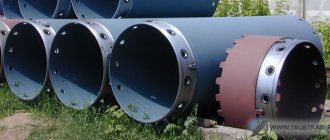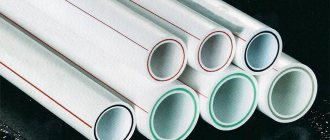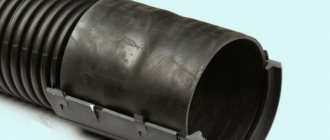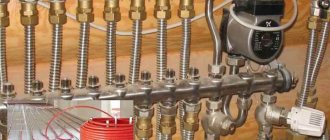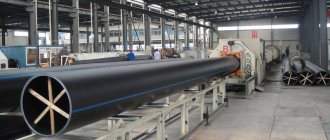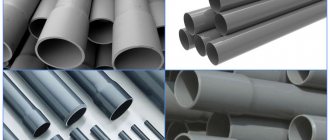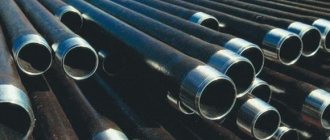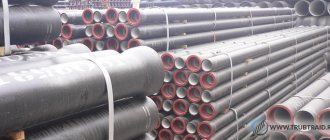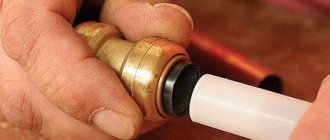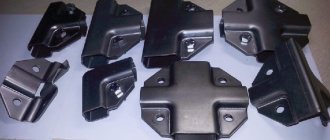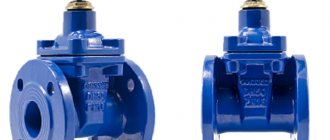To solve the issue of transit of various liquids and gases, pipe manufacturing plants offer a variety of products. These are pipes for various purposes, made from various materials.
Among them, pipes made of low-density polyethylene occupy a special place. Objectively, they have a number of solid advantages that ensure sustainable popularity among the end consumer. Non-corrosive, easy to install, unpretentious in operation, they successfully solve the problems of cold and hot water supply, gas supply, transportation of technical liquids (acids, alkalis, solvents), drainage and irrigation of land. In addition, they also compare favorably with their affordable prices.
Note! The unknowing discovery of polyethylene occurred in 1899 in Germany. Scientists were able to understand the practical value of this material only in 1933, and it was at this time that the new polymer was patented.
Installation of HDPE pipes and compression fittings.
Fittings are used for installation of polyethylene pipes.
The fittings are connected to the pipe using crimp clamps, which are similar in principle to collet connections from metal-plastic. If you follow all the conditions and rules of crimping, the connection will be strong and durable. Push-in or compression fittings are convenient in pipeline assembly due to their ease of installation. There is also a variety of threaded compression fittings. The tightness of compression fittings is ensured by a rubber ring, which is clamped with a nut. To press the fitting tightly, you can use a regular gas wrench or a spring-loaded one, but be careful not to damage the connecting structure. To make the connection tight and airtight, it is necessary to push the pipe into the fitting until it stops.
If necessary, you can remove the chamfer to make the pipe fit easier. If the pipe is not inserted all the way, a leak will occur after a while. For additional density, the joints are lubricated with sealant.
When installing water supply from HDPE pipes
, it should be remembered that direct sunlight has a destructive effect on them.
Accordingly, it is necessary to hide the pipes from the sun. If the water supply is located underground, the pipes are installed not in a straight line, but in a snake. This rule must be observed, since in HDPE pipes
the coefficient of thermal expansion is quite high, and if the water supply was laid in the summer, then its length is slightly longer than in winter.
During the cold season, the water temperature is low, and the pipe length decreases accordingly, stress occurs and a rupture may occur. Thus, we can say that HDPE pipes
are an excellent option for laying appropriate communications, since they are an ideal option in terms of price-quality ratio.
.You can call our managers by phone +7 (351) 222-10-92 and consult on any questions that interest you. VIKO company website: www.td-viko74.ru "VIKO" - engineering plumbing in Chelyabinsk
Areas of use
They are mainly used to build pipelines, which in turn deliver water for domestic and economic needs. But due to their many positive properties, they are also used for other purposes, such as:
- installation of gas pipelines;
- underground water pipelines;
- drainage of underground, groundwater and wastewater;
- water insulation on heating mains;
- watering cultivated plants, constantly feeding them with carbon dioxide.
What is HDPE Pipe - its characteristics, use and photos. Tips: find out
HDPE pipes are widely used in repairs and installation of utilities. This is an ideal option for both small private houses and spacious cottages. Low cost, simple installation, long service life and versatility of use often force one to choose pipes made from this material.
Material for production.
Sometimes HDPE pipes are called polyethylene pipes. They are tested against high temperature water, a variety of chemical compounds and solvents.
How suitable they are for this function can be seen in the certificate, where this information is written down.
HDPE pipes are made of polyethylene. A method is used, the essence of which is the continuous extrusion of the molten mass. Initially, raw materials can enter a special department in the form of powder or granules.
There are two main types of work in the production of polyethylene.
High pressure. With this technological process, the output is a material with low density. It is plastic and soft and cannot be used for pipes. But it’s good for packaging.
Low pressure (20 atmospheres and 150 degrees Celsius) At the output, polyethylene already has high density and strength. Pipes are made from it.
HDPE pipe characteristics
Advantages in use.
- HDPE pipes can be used for up to 50 years. They are not exposed to chemical elements, do not oxidize and do not rust.
- When laying a water supply pipe, you do not need to use additional devices for protection and insulation.
- The walls of polypropylene pipes have a smooth surface, which prevents sediment and silt from accumulating. Due to low thermal conductivity, there is practically no condensation on the outside.
- Fracture due to low temperatures is virtually impossible. Pipes have the ability to increase in diameter without breaking and return to their original state.
- Savings on transportation, because a cubic meter of such a product weighs less than a ton. This is 6 times lower than analogues made from other materials.
- Technically simple welding. HDPE pipe connections do not deform over time.
- Environmentally friendly material. Even with high requirements, polyethylene pipes are widely used in Europe.
Disadvantages in application.
- Installation technology sometimes requires an atypical approach.
- There are restrictions on use due to temperature. Sometimes hot water is not available for use.
- The duration of use is affected by the mobility of the soil at the site and UV exposure. These criteria may reduce the operating period.
Types of pipe costs
The first ones are used for water supply and gas communications. The second is for stormwater and fecal systems.
The distinction between types according to purpose is as follows:
- HDPE PE 80 is used to move flammable gases,
- marked 100 are used in water supply and sewerage systems. In addition, they are used in gasification,
- with the PROSAFE designation can be laid with or without trenches. They are used to provide homes with both hot water and gas. Their declared service life is 100 years.
Their cost depends on the technical characteristics:
- internal and external diameter, respectively, wall thickness,
- type of pipes The cost of products marked 80 is lower than those with an index of 100, all other things being equal.
Fittings are used for installation. Pipes can be joined together by two types of soldering - socket and butt.
Fittings are either compression or electric welded. In the first case, a special rubber ring is pressed with a nut. Installation is reminiscent of the technology for connecting metal-plastic pipes.
When using a wrench or spring wrench, you must be careful not to damage the integrity of the structure.
Electrofusion fittings are more expensive.
Their design has a special heating element. Using the code on them, you can determine the required voltage and soldering time.
Due to the destructive effects of sunlight, it is recommended to lay plastic pipes in such a way that the area exposed to UV rays is minimal.
If the system is installed underground, then the HDPE pipes should be laid in the form of a snake.
This is due to the temperature difference between winter and summer, as well as the large coefficient of thermal expansion.
Long service life at low prices is a huge advantage. This is why they are so widely used.
What is HDPE Pipe - its characteristics, use and photo
HDPE pipe and its characteristics. Pros and cons of pipes for water supply or sewerage of a private house. Connections and fittings, do-it-yourself installation and prices. Find out =>,
Specifications. Marking
According to GOST, such products are designated not by the letters HDPE, but by PE (polyethylene). They can be marked either by embossing or using a printer with paints. In this case, the following must be indicated:
- name of GOST according to which the product was manufactured;
- manufacturing company;
- type of material (PE);
- strength (density): its indicator is the numbers following the first letters; for example, the designation PE100 is used for products of greater strength; PE80 pipes are not as durable and can withstand less load;
- outer and inner diameter;
- wall thickness;
- nominal (working) pressure at which the product can be operated;
- maximum pressure;
- production date and batch number.
In addition to the above parameters, the markings indicate the letters SDR. This is the strength of the walls. The numbers following the letters show how the outer diameter relates to the wall thickness, that is, how capable they will be of resisting pressure changes. The smaller the numbers following the SDR, the stronger the product. But the weight of such a HDPE pipe will be significant.
The S marking and the numbers following it are also considered an indicator of strength
However, this indicator is more laboratory, and users rarely pay attention to it
PE pipe marking
Technical characteristics and installation features of polyethylene pipes
Pipes made of low-pressure polyethylene or simply polyethylene products are used only for laying cold pipelines. After all, from hot water the material immediately loses its performance characteristics. There are also restrictions on installation - HDPE material is only allowed to be used inside houses or in trenches at a depth where the ground does not freeze. With all this, HDPE products are in demand due to their low cost and ease of installation.
Characteristics of HDPE pipes
Technical features
HDPE pipes are made from low-density polyethylene. It is the properties of this material that determine the technical characteristics of the products:
- lightness - the weight of a cubic meter of HDPE is 900 kilograms, which simplifies the installation of pipes,
- resistance to pressure of tens of atmospheres, ultimate strength is 3-5 MPa,
- limitation of the operating temperature regime - at temperatures below 0°C HDPE becomes glassy, and when exceeding 40°C it loses its ring rigidity,
- slight thermal expansion - when heated to 70°C, a low-density polyethylene product increases by only three percent.
Scope of application
Products made from low-density polyethylene are used for
- laying pipelines for transporting drinking or process water with temperatures up to 40°C,
- laying pipelines for transporting gaseous or liquid materials with temperatures below 40°C,
- laying fecal or storm sewer systems,
- construction of a box or insulating layer for electrical cables (HDPE corrugated pipes are produced for these purposes).
It is also important that the transported material does not react with polyethylene and is inert to this substance
HDPE pipe standards
Acceptable product parameters are specified in GOST 18599, published in 2001. This document regulates the diameter and thickness of the walls. These parameters are closely related to the type of polymer used.
- The diameter range of pipes made of PE 33 polyethylene is 10-160 mm with a wall thickness of 2-12 mm. But such products are extremely unreliable at high pressure - at a load of more than 3.2 MPa, the material will burst.
- The use of another polymer, grade PE 100, creates conditions for the production of large-sized products. Now the diameter will range from 32 mm to a meter with a wall thickness of 1-59 mm. The working pressure of the liquid in such a pipeline is permissible up to 10 MPa.
- Polymer grades PE 63 and PE 80 allow you to create large-sized products. In this case, the permissible initial diameter is only 16 mm with a wall thickness of 2-67 mm. A gaseous or liquid carrier is supplied into such a pipeline under a pressure of 6.3-8 MPa.
The assortment consists of 34 original products based on diameter alone. There are also 15 standard sizes of products from grade PE 33, 30 standard sizes from grade PE 63, 34 products from grade PE 80 and 26 products from grade PE 100. This variety of products allows customers to choose a product based on the required technical characteristics and throughput.
Marking
To simplify the selection of HDPE pipes and prevent errors during their installation, the appropriate markings are applied to the external surface of the products:
- name of the manufacturer and GOST 18599-2001, according to the standards of which the products are manufactured,
- the type of polyethylene used,
- the size of the assortment, that is, the outer diameter - for example, HDPE pipe 25, 32, 50, 63 or even 225 mm, which determines the characteristics and throughput of the product,
- the following value indicates the wall thickness in millimeters,
- rated operating and maximum permissible pressure in MPa,
- date of manufacture and batch number.
It should be noted that the products are also marked with color stripes. Yellow indicates the possibility of using pipelines to transport gas, and blue indicates the laying of water supply networks.
Often the measured lengths of HDPE pipes are 5-24 meters. Although polyethylene water pipelines with a diameter of up to 180 millimeters are sold in bays with a length of 30-40 meters, and sometimes up to 0.5 kilometers, such water supply networks are made with a minimum number of couplings, which is convenient when constructing an external water supply network.
Advantages
Despite a number of limitations, such products have significant advantages.
Technical characteristics and installation features of polyethylene pipes
High-quality and inexpensive HDPE pipes are used for laying water pipelines, transporting gas and insulating electrical cables.
General information
However, polyethylene pipes have several disadvantages: they are prohibited from being used for heating and for transporting hot water. They also do not tolerate UV radiation, because when exposed to it, the material loses elasticity and loses strength.
Polyethylene pipes now have a place in construction. They are often used to construct sewer and water supply structures.
Despite this, during the manufacture of pipes, each type is checked for compliance with all the properties declared by the manufacturer: reliability when interacting with temperatures, rupture, and increasing operating pressure.
HDPE pipe can be used for installation in the ground or indoors. It provides protection against possible defects during use.
Another area of application is laying power lines. They do a good job of protecting against damage from outside, electricity and earth.
HDPE plastic pipes from the manufacturer.
The production of HDPE pipes by a reliable manufacturer guarantees that the client will buy high-quality products at a profit, and their operation will not cause problems. Therefore, if you are looking for really good HDPE plastic pipes for laying sewers, installing drains, laying optical and electrical cables, then you have come to the right place. Our company is engaged in the production and sale of smooth technical pipes - products that are distinguished by their durability and versatility. Working with a professional team, you get:
- Save money by purchasing products from the manufacturer without intermediaries, while spending money on the type of pipes that you really need at the moment.
- Free consultation and related documents for products, as well as a warranty on operation.
- Production of technical pipes of any shape you need.
- Cooperation with private entrepreneurs and large industries in Moscow and the Moscow region.
- Convenient location of a company producing HDPE pipes in the Moscow region.
Our clients have the opportunity to pay using any suitable method. Delivery is negotiated individually with each client: flexible prices and delivery times for everyone.
HDPE pipes: marking, application, manufacturers
On average, polyethylene pipes last three times longer than steel pipes. They are not subject to corrosion and will not collapse when the liquid freezes. And such products are lighter than steel pipes. That is why most builders give them preference when laying pipelines.
Where are HDPE pipes used?
We can see the widespread use of HDPE pipes:
- in water heating,
- hot water supply,
- in indoor plumbing systems,
— in external sewerage, gas or water supply networks,
— in laying the communication cable,
— in protecting power electrical cables from mechanical damage.
Product marking
Marking of HDPE pipes is one of the ways to control the compliance of the performance characteristics of the product and its quality with the data indicated in the documentation. The marking must be applied in one line with the same size and font. The following information must be printed on the polyethylene tube:
— a quality mark, which indicates the product’s compliance with the requirements of the standard,
- full name of the manufacturer or trademark, which is registered in the prescribed manner,
- code, as well as the number of the international or national standard according to which the pipes are manufactured,
— data about the material. The marking of pipes made of material grades PE100, 80 and 63 is carried out as MRS 10,8,3 and 6. Cross-linked polyethylene has the PEX marking with codes a, b, c, d. The PEX designation is the material code, and the letters indicate the crosslinking method,
— the size of the minimum wall thickness and outer diameter. Dimensions are indicated in millimeters. There are more than two dozen pipes with a diameter of 10 mm and ending at 1200 mm,
— nominal pressure. It is expressed in bars. By nominal pressure we mean the internal water pressure that the pipe can withstand at +20 degrees and its service life is 50 years,
The marking separately indicates the possibility of using pipes for domestic gas at standard pressure, as well as pipes intended for transporting drinking water,
- batch number, release date and origin of raw materials in the letter index.
Where are polyethylene pipes produced in Russia?
Over the past years, the production of HDPE pipes in Russia has been developing very actively. And the entire main share of pipes manufactured in Russia falls on these products. Today, more than 90 Russian enterprises are engaged in the production of these pipes, and the demand for the product is constantly increasing. The largest volumes of pipes are produced in the Central, Volga, Ural and North-Western regions, but in the Far East and North Caucasus production is still poorly established. For example, OJSC Kazanorgsintez produces polyethylene pipes for gas pipelines, and the company also produces pressure pipes. Until 2006, the company produced products of the PE-80 and PE-63 brands, but in the same year the PE-63 brand was discontinued as it was considered obsolete. Therefore, production capacity is primarily aimed at producing PE-80 products, which meet international standards.
How much does it cost to lay HDPE pipes?
The cost of laying HDPE pipes will depend on the initial conditions. Usually the price is calculated for ideal conditions, when there is no intersection with communications, and there is no need to secure the trench walls with formwork. Also, the price depends on the diameter of the pipe. The price for laying HDPE water pipes DN 50 mm in an open way will be 2,000 rubles per linear meter. Laying one linear meter of water supply pipes HDPE pipes DN 100 mm - 2500 rubles, and the price for laying HDPE pipes DN 160 mm - 3100 rubles.
HDPE pipes: marking, application, manufacturers
On average, polyethylene pipes last three times longer than steel pipes. They are not subject to corrosion and will not collapse when the liquid freezes. Yes and easier
What is LDPE in pipe production and how is it deciphered?
The abbreviation LDPE as applied to pipe production stands for pipes made of polymer materials under high pressure. The material is durable and flexible, therefore it is used for laying communications for various purposes: water pipes, drainage pipelines and as insulating protective shells for electrical networks. In private housing construction, LDPE pipes are used for wells. Their main advantage is their ability to withstand slight soil movement and the pressure of the transported liquid.
Advantages of PVD
Polyethylene produced under high pressure conditions is characterized by thermal and chemical stability, low weight and, accordingly, ease of use: these pipes are easier to install and transport.
But despite all its lightness, it is a fairly durable, soft and flexible material that can withstand serious loads:
- deformation and mechanical impact: compression, tension, impacts of varying strength,
- freezing will not cause pipe rupture,
- chemical attack and corrosion are not dangerous for LDPE pipes,
- the maximum pressure value that is permissible when using LDPE pipes is 25 atmospheres,
- operating temperature - 40°C, in case of accidents - their limit is 80°C.
LDPE and HDPE - what's the difference?
LDPE is produced from ethylene granules by polymerization. Temperature loads and exposure to high pressure are the main factors that give polymers their characteristic properties (ductility and strength) and distinguish them from polyethylene produced under low pressure conditions, which also serves as a material for pipes, but is characterized by greater rigidity and resistance to chemical influences, but at In this case, HDPE pipes are less durable, can rupture and deform from mechanical stress, and also contain more impurities, which are used for polymerization under low pressure.
LDPE does not emit toxins, since it contains no additional substances, and, therefore, the material can be used in the production of pipes for drinking water supply systems, and such pipes can be laid directly into the ground without any protective shells.
Note! LDPE is used exclusively for liquid media, while HDPE is used for supplying gas, technical and household liquids, fuel, and for laying cables
Types of LDPE pipes
Two basic brands of domestic polyethylene serve as raw materials for the manufacture of pipes in accordance with GOST: PVD-108 and PVD-158.
- No. 108 - considered the best material for pipe production. This polyethylene has anti-corrosion properties and is not subject to rotting or destruction.
- No. 158 - used for the manufacture of thin-walled products. The difference between polymers is that the first is a more rigid and durable material, while the second is smoother and contains almost no inclusions.
LDPE pipes differ in diameter and wall size, but, in addition, there are differences in structure; they can be either single-layer or combined, that is, they consist of two types of polyethylene: LDPE and HDPE. For example, two-layer ones - from an external corrugated HDPE layer and a smooth HDPE layer inside, thereby combining the two main properties of each type (strength and flexibility) in one pipe. Three-layer pipes can be additionally reinforced with synthetic thread.
What is LDPE in pipe production and how is it deciphered?
What is LDPE - definition of the term, what is the difference between LDPE and HDPE in pipeline systems, material properties, types of high-pressure polyethylene pipes.
Product requirements
According to established standards, products must:
- Comply with sanitary, epidemiological and hygienic requirements;
- have a flat, smooth surface both outside and inside. The presence of foreign inclusions, cracks, depressions or bubbles is not allowed;
- withstand loads in accordance with the declared classes;
The ignition temperature of the material should not be lower than 300°C.
In addition, the manufacturer is obliged to include information about the purpose and technical parameters of the product along the entire length. The gap between the markings should not exceed 1 m.
Important! The method by which the marking is applied must not compromise the integrity of the pipe. Thermal embossing or painting by which the marking is applied must not cause cracking or corrosion of the material.
What is HDPE pipe
HDPE as a material for pipes has many advantages and few disadvantages.
Advantages of polyethylene pipelines:
- durability. In the absence of critical pressure, temperature and ultraviolet radiation, polyethylene lasts a very long time. The service life of the first communications in the ground already reaches 50 (!) years;
- strength; resistance to hydraulic shocks; lack of fragility, ability to recover from deformation;
- frost resistance – polyethylene can withstand temperatures down to -60°C;
- harmlessness to people;
- very low price;
- corrosion resistance – plastic does not rust and does not require regular anti-corrosion treatment and painting;
- chemical inertness – polyethylene is resistant to acids (except 50% nitric acid) and alkalis, petroleum products; water in PE pipelines does not acquire any tastes or odors;
- environmental friendliness - plastic can be recycled;
- plasticity and flexibility - the HDPE pipe can withstand pressure when frozen with water, and after defrosting it returns to its original shape; when installing, workpieces of small outer diameter can be easily bent on a mandrel or simply by hand;
- smooth internal walls have little adhesion - the pipeline does not become overgrown with calcium and magnesium salts during operation;
- the low weight of plastic makes installation and transportation easier - the weight of one meter of HDPE pipe is about 8 times less than that of a metal one;
- easy installation - polyethylene is easy to cut, bend and assemble using fittings, welding or sockets.
Disadvantages of HDPE pipes:
- UV instability. Polyethylene cannot be used outdoors - only in the ground and indoors;
- low resistance to elevated temperatures - the recommended operating temperature for HDPE is 50°C; permissible for a short time - 80°C; long straight sections of pipeline may “lead” when heated;
- the maximum permissible pressure of 2.0 MPa limits the use of HDPE in industry;
- black-striped or bright blue water pipes are not very aesthetically pleasing for installation indoors.
Technical characteristics of HDPE pipes
General characteristic features of HDPE pipes can be presented in the following table:
| Application | Pressure pipeline systems, wells, pumping systems, electrical wiring protection, gas lines. |
| Color version | Black color. On pipes, a bright longitudinal stripe is applied along the side surface: yellow - on pipes for gas transportation, blue - for water. Pipe products for technical applications and sewerage do not have color stripes. |
| Life time | up to 50 years |
| Flexibility | High |
| Operating temperature indicators | -20 to +40°С. |
| Maximum temperatures | -70 to +80°С. |
| Section size | Standard version - up to 120, available up to 150. |
| Pressure indicators | 6-25 atm. |
| Strength | Up to 38 MPa |
| Interaction with aggressive environments | Does not corrode, with gases and water - it works neutrally, when laying an electric cable inside a pipe it has dielectric properties. |
| Installation methods | Socket, fitting, electric welded connection. |
| Available sizes, m | Coils - 100, 200, 1000 m. Also available in lengths up to 12 m. |
HDPE pipes are marked with the PE sign, indicating that the product is made from polyethylene. Several modifications are used - PE 63, PE 80 and PE 100. The numerical indicator informs about the number of bonds of ethylene molecules in the structural lattice of the polymer, the ratio of the number of bonds to the total number of molecules.
Indicators 63, 80 and 100 characterize the pipe’s ability to withstand pressures of 6.3, 8, 10 MPa, respectively.
SDR
The second important indicator in determining the technical characteristics of a pipe is the standard pipe size ratio (SDR index), which is defined as the ratio of the cross-sectional size of the pipe to the thickness of its wall. Using the SDR index, you can determine where the pipe can be used.
| SDR | Maximum pressure, atm. | Application area |
| 6 | 25 | Pressure lines, pipelines for water supply, installation of sewer pressure collectors, gas lines. |
| 7,4 | 20 | |
| 9 | 16 | |
| 11 | 12 | Low-pressure systems for water transportation, irrigation lines. |
| 13,6 | 10 | |
| 17 | 8 | |
| 17,6 | 7 | |
| 21 | 6 | Intra-house low-pressure water supply for low-rise buildings |
| 26 | 5 | Intra-house low-pressure water supply for low-rise buildings, free-flow (gravity) sewer outlets |
| 33 | 4 | |
| 41 | 4 |
Diameter matching
To connect metal fittings and pipes with HDPE products, you can use various adapters that increase or decrease the diameter of the components of the water supply system.
In addition, it is possible to use the correspondence of certain sizes of products made of different materials. Pipes made of polymers and steel are conditionally identical in outer diameters:
| Dн – outer diameter, mm | ||||
| Conditional bore, Dу, mm | Thread, G, mm | PP, PVC, HDPE | Water and gas pipelines | Electric welded |
| 150 | 6 | 160 | 165 | 159 |
| 125 | 5 | 125 | 140 | 133 |
| 100 | 4 | 110 | 114 | 108 |
| 90 | 3Х1/2 | 101,3 | ||
| 80 | 3 | 90 | 88,5 | 89 |
| 65 | 2Х1/2 | 75 | 75,5 | 76 |
| 50 | 2 | 63 | 60 | 57 |
| 40 | 1Х1/2 | 50 | 48 | 45 |
| 32 | 1Х1/4 | 40 | 42,3 | 42 |
| 25 | 1 | 32 | 33,5 | 32 |
| 20 | 3/4 | 25 | 26,8 | 26 |
| 15 | 1/2 | 20 | 21,3 | 20 |
| 10 | 3/8 | 16 | 17 | 16 |
How are they produced?
HDPE is produced in devices with a pressure below 0.1–2 MPa; temperature 120–150 °C; in the presence of metal halide catalysts (most often a mixture of TiCl4 and AlR3). Petroleum products are used for the reaction. The degree of crystallization of HDPE is 75–80%.
HDPE products, regardless of size, are made by extrusion, squeezing molten polyethylene through an extruder.
Production technology
First, polymer granules are poured into an extruder and melted while mixing. Then the PE is extruded through the outlet of the extruder, calibrated, and slowly cooled. The finished products are cut and packaged.
Physical parameters
Pipes are sold in coils up to 500 m or in sections from 3 to 24 m. The wall thickness can be 5-53.3 mm. The weight of a linear meter, depending on the composition, is in a wide range: PE-1 up to 8.13 kg, other products can weigh more than 250 kg.
Sections and coils of finished products Source yandex.net
Decoding
Only a doctor can decipher the F-50 blood test and make an accurate diagnosis, because the same results in different cases can indicate different symptoms.
Qualitative analysis:
- Screening - if there are no antibodies in the blood, then the answer is indicated “negative”. If antibodies to the virus are detected, then a repeat test is carried out. In case of double confirmation of the result, indicate “positive”.
- Verification analysis allows you to assess the presence of a virus by darkening at the locations of certain proteins. With other pathologies, changes on the test strip occur in other parts.
Summing up.
It is better to purchase HDPE pipes for economic activities of various types directly from the manufacturer. Our plant produces products that one hundred percent meet all technical standards. In conclusion, we list a number of the main positive properties that HDPE pipes have.
- Low degree of roughness: since HDPE pipes are smooth, they have a low degree of resistance to flow;
- Do not corrode, unlike metal pipes;
- Resistant to stray currents - dielectric;
- They have high wear resistance;
- Products tolerate temperature changes normally;
- Sealed;
- They are completely environmentally friendly and do not pollute the environment with toxic waste, and are also recyclable.
- HDPE pipe sizes and shapes are varied, which allows you to choose products that are suitable for each specific case.
If you have a desire to improve your sewer system, correctly lay all communications in a private house (apartment), or need to reliably install a drain, call our specialists at any time. Our employees will listen carefully and suggest the appropriate type of pipes and possible options for their fastening.
Benefits of epoxy coating
The difference between pipes with an internal epoxy coating and conventional metal products is the presence of a continuous polymer protective layer. Manufacturers expect that the pipes will serve for a long time at temperatures from -35 to +180 degrees.
Epoxy coating is protection against erosion and corrosion, temperature changes, cathodic disbonding, abrasive wear, and aggressive environments. In addition, epoxy coated pipes have the following advantages:
- Long service life.
- Increased throughput with reduced hydraulic flow resistance, which is explained by anti-friction properties.
- The ability to resist stray currents, chemical reactions, scale, deposits, and biological fouling.
- Easy joining using metallization and bushings. The protective surface is not damaged.
- Resistant to waste water, as well as carbon dioxide and hydrogen sulfide.
- Performing its immediate function is constant contact and transportation of various mixtures.
Today, epoxy-coated pipes meet government and industry standards almost as well as polyethylene-coated pipes. However, they have several additional advantages, the main one of which is high resistance to abrasive wear. The excellent quality of the pipes makes it possible to use such products for work in microtunnels, under roads, in underwater construction, and during inclined drilling.
